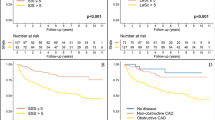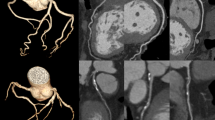Abstract
To assess the prognostic value of coronary artery stenosis identification by coronary computed tomographic angiography (CCTA) for the prediction of major adverse cardiac events (MACE) in a multicenter prospective cohort study. We performed a prospective multicenter observational cohort study of symptomatic patients with suspected or known coronary artery disease (CAD) (n = 172; 57% male) undergoing CCTA in accordance to ACC/AHA Appropriateness Criteria from 4 sites in and around Paris, France, and followed for a mean duration of 22.0 ± 4.5 months (interquartile range 18–26 months). Coronary arteries by CCTA were interpreted by physicians blinded to the patient characteristics for the presence or absence obstructive (≥70% luminal diameter stenosis), as well as for plaque composition categorized as non-calcified, calcified or “mixed.” MACE was defined as death, non-fatal myocardial infarction, unstable angina or target vessel revascularization. MACE event rates were compared between patients with or without obstructive plaque and with differing plaque compositions. MACE event rates were significantly higher in patients with obstructive coronary artery stenosis by CCTA compared to those without (61.1% vs. 3.9%, P < 0.01). In patients with obstructive stenosis, mixed (83.3% vs. 25.3%, P < 0.01) and calcified (94.4% vs. 50.7%, P < 0.01) plaque presence was significantly higher than in patients without obstructive stenosis, with no differences in prevalence of non-calcified plaque (27.8% vs. 20.8%, P = NS). For MACE, the negative predictive value of no observed coronary artery plaque was 100% in the follow-up period. In this prospective multicenter study of symptomatic patients with suspected or known CAD undergoing CCTAs interpreted by imagers blinded to patient characteristics, CCTA presence of plaque severity and composition successfully identifies patients at risk for incident MACE events. Importantly, a negative CCTA portends an extremely low risk for incidence MACE.



Similar content being viewed by others
References
Berman DS, Shaw LJ, Hachamovitch R, Friedman JD, Polk DM, Hayes SW, Thomson LE, Germano G, Wong ND, Kang X, Rozanski A (2007) Comparative use of radionuclide stress testing, coronary artery calcium scanning, and noninvasive coronary angiography for diagnostic and prognostic cardiac assessment. Semin Nucl Med 37:2–16
Min JK, Wann S (2007) Indications for coronary and cardiac computed tomographic angiography. Cardiol Rev 15:87–96
Hamon M, Morello R, Riddell JW, Hamon M (2007) Coronary arteries: diagnostic performance of 16- versus 64-section spiral CT compared with invasive coronary angiography—meta-analysis. Radiology 245:720–731
Hamon M, Biondi-Zoccai GG, Malagutti P, Agostoni P, Morello R, Valgimigli M, Hamon M (2006) Diagnostic performance of multislice spiral computed tomography of coronary arteries as compared with conventional invasive coronary angiography: a meta-analysis. J Am Coll Cardiol 48:1896–1910
Gilard M, Le Gal G, Cornily JC, Vinsonneau U, Joret C, Pennec PY, Mansourati J, Boschat J (2007) Midterm prognosis of patients with suspected coronary artery disease and normal multislice computed tomographic findings: a prospective management outcome study. Arch Intern Med 167:1686–1689
Meijboom WB, van Mieghem CA, Mollet NR, Pugliese F, Weustink AC, van Pelt N, Cademartiri F, Nieman K, Boersma E, de Jaegere P, Krestin GP, de Feyter PJ (2007) 64-Slice computed tomography coronary angiography in patients with high, intermediate, or low pretest probability of significant coronary artery disease. J Am Coll Cardiol 50:1469–1475
Lesser JR, Flygenring B, Knickelbine T, Hara H, Henry J, Kalil A, Pelak K, Lindberg J, Pelzel J, Schwartz RS (2007) Clinical utility of coronary CT angiography: coronary stenosis detection and prognosis in ambulatory patients. Catheter Cardiovasc Interv 69:64–72
Min JK, Shaw LJ, Devereux RB, Okin PM, Weinsaft JW, Russo DJ, Lippolis NJ, Berman DS, Callister TQ (2007) Prognostic value of multidetector coronary computed tomographic angiography for prediction of all-cause mortality. J Am Coll Cardiol 50:1161–1170
Pundziute G, Schuijf JD, Jukema JW, Boersma E, de Roos A, van der Wall EE, Bax JJ (2007) Prognostic value of multislice computed tomography coronary angiography in patients with known or suspected coronary artery disease. J Am Coll Cardiol 49:62–70
Hendel RC, Patel MR, Kramer CM, Poon M, Hendel RC, Carr JC, Gerstad NA, Gillam LD, Hodgson JM, Kim RJ, Kramer CM, Lesser JR, Martin ET, Messer JV, Redberg RF, Rubin GD, Rumsfeld JS, Taylor AJ, Weigold WG, Woodard PK, Brindis RG, Hendel RC, Douglas PS, Peterson ED, Wolk MJ, Allen JM, Patel MR (2006) ACCF/ACR/SCCT/SCMR/ASNC/NASCI/SCAI/SIR 2006 appropriateness criteria for cardiac computed tomography and cardiac magnetic resonance imaging: a report of the American College of Cardiology Foundation Quality Strategic Directions Committee Appropriateness Criteria Working Group, American College of Radiology, Society of Cardiovascular Computed Tomography, Society for Cardiovascular Magnetic Resonance, American Society of Nuclear Cardiology, North American Society for Cardiac Imaging, Society for Cardiovascular Angiography and Interventions, and Society of Interventional Radiology. J Am Coll Cardiol 48:1475–1497
Danciu SC, Herrera CJ, Stecy PJ, Carell E, Saltiel F, Hines JL (2007) Usefulness of multislice computed tomographic coronary angiography to identify patients with abnormal myocardial perfusion stress in whom diagnostic catheterization may be safely avoided. Am J Cardiol 100:1605–1608
Lin F, Shaw LJ, Berman DS, Callister TQ, Weinsaft JW, Wong FJ, Szulc M, Tandon V, Okin PM, Devereux RB, Min JK (2008) Multidetector computed tomography coronary artery plaque predictors of stress-induced myocardial ischemia by SPECT. Atherosclerosis 197:700–709
Naghavi M, Libby P, Falk E, Casscells SW, Litovsky S, Rumberger J, Badimon JJ, Stefanadis C, Moreno P, Pasterkamp G, Fayad Z, Stone PH, Waxman S, Raggi P, Madjid M, Zarrabi A, Burke A, Yuan C, Fitzgerald PJ, Siscovick DS, de Korte CL, Aikawa M, Juhani Airaksinen KE, Assmann G, Becker CR, Chesebro JH, Farb A, Galis ZS, Jackson C, Jang IK, Koenig W, Lodder RA, March K, Demirovic J, Navab M, Priori SG, Rekhter MD, Bahr R, Grundy SM, Mehran R, Colombo A, Boerwinkle E, Ballantyne C, Insull W Jr, Schwartz RS, Vogel R, Serruys PW, Hansson GK, Faxon DP, Kaul S, Drexler H, Greenland P, Muller JE, Virmani R, Ridker PM, Zipes DP, Shah PK, Willerson JT (2003) From vulnerable plaque to vulnerable patient: a call for new definitions and risk assessment strategies: part I. Circulation 108:1664–1672
Berman DS, Wong ND, Gransar H, Miranda-Peats R, Dahlbeck J, Hayes SW, Friedman JD, Kang X, Polk D, Hachamovitch R, Shaw L, Rozanski A (2004) Relationship between stress-induced myocardial ischemia and atherosclerosis measured by coronary calcium tomography. J Am Coll Cardiol 44:923–930
Min JK, Lin FY, Dunning AM, Delago A, Egan J, Shaw LJ, Berman DS, Callister TQ (2010) Incremental prognostic significance of left ventricular dysfunction to coronary artery disease detection by 64-detector row coronary computed tomographic angiography for the prediction of all-cause mortality: results from a two-centre study of 5330 patients. Eur Heart J. doi:10.1093/eurheartj/ehq020
Chow B, Wells G, Chen L et al (2010) Prognostic value of 64-slice cardiac computed tomography severity of coronary artery disease, coronary atherosclerosis, and left ventricular ejection fraction. J Am Coll Cardiol 55:1017–1028
Author information
Authors and Affiliations
Corresponding author
Rights and permissions
About this article
Cite this article
Min, J.K., Feignoux, J., Treutenaere, J. et al. The prognostic value of multidetector coronary CT angiography for the prediction of major adverse cardiovascular events: a multicenter observational cohort study. Int J Cardiovasc Imaging 26, 721–728 (2010). https://doi.org/10.1007/s10554-010-9613-4
Received:
Accepted:
Published:
Issue Date:
DOI: https://doi.org/10.1007/s10554-010-9613-4




